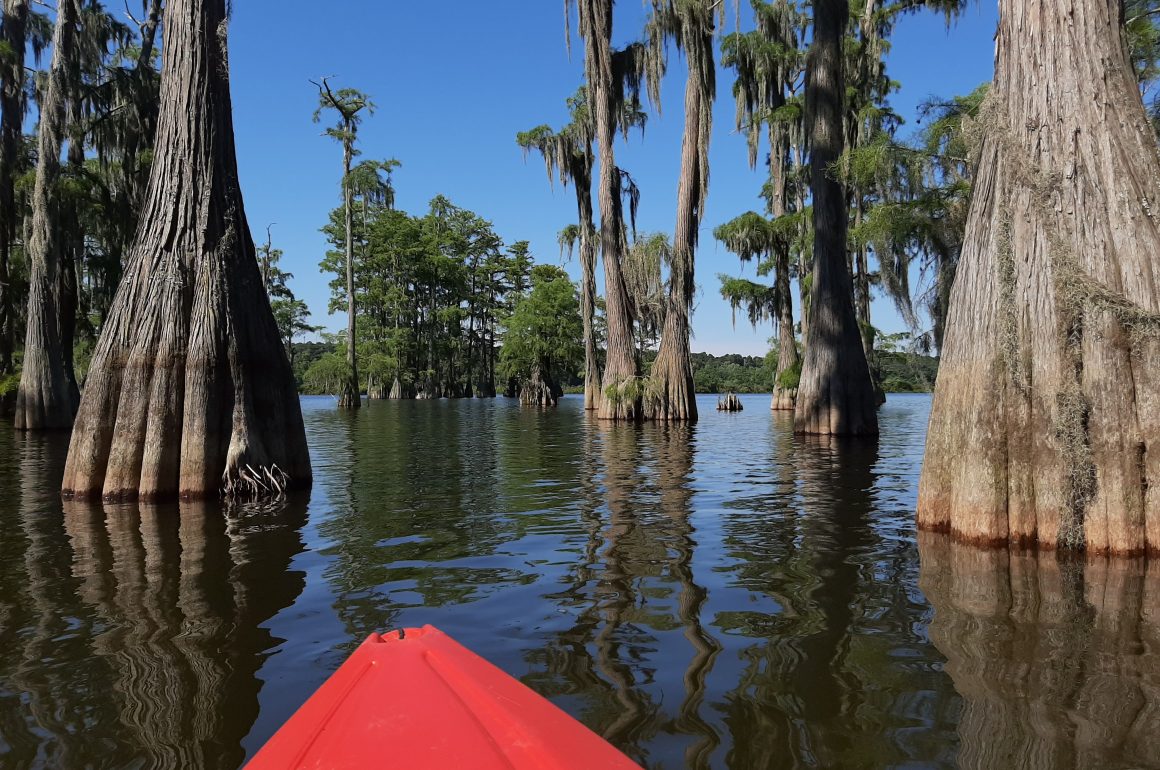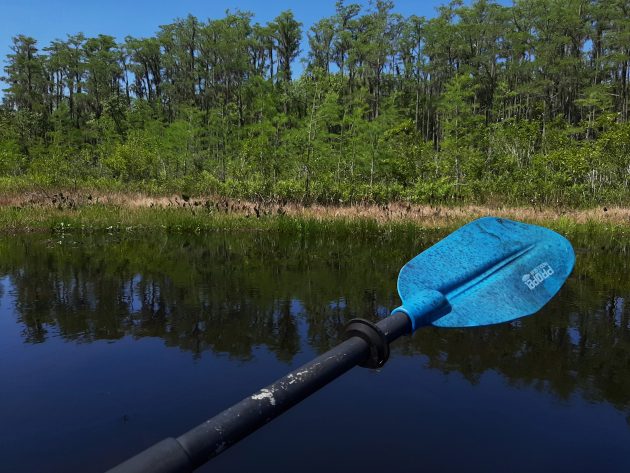
Four months ago, a full parking lot wouldn’t have caused my blood pressure to spike. Four months ago, I would have taken to the crowded pathway at Lafayette Heritage Trail Park like a horse to pasture, reveling in the outdoor exercise and rare time away from my new baby. Four months ago, I wouldn’t have mentally counted the distance between me and every person who passed by, the words “six feet, six feet, six feet” pounding through my brain like a cult mantra.
But it wasn’t four months ago, it was mid-June, 2020, mid-COVID-19 pandemic. The week before I had tried to walk this trail with my parents and son in the baby jogger, but the constant need to veer off the pathway to avoid those less observant of CDC guidance made the experience more stressful than enjoyable.
Now, we would try again, just me and my mother. Instead of pulling on running shoes, we unloaded two bright red kayaks from the back of my old, beat-up truck, lugging them 100 feet down a grassy slope towards Piney Z Lake. The trails may have been buzzing with joggers, dog-walkers, and bikers, but the water was empty.
As of June, COVID-19 had barely touched Tallahassee, FL. Only 20 or so miles south of Georgia, we had experienced about 500 cases, our uptick slow, steady, and manageable. While the rest of Florida’s caseload had started to spike, ours continued to plod along, just high enough that the virus could still be anywhere, and constant vigilance felt not only like my motherly duty, but also my civic obligation. I had read enough stories of young people my age laid up in the ICU or sick for weeks to know I would do whatever it took to avoid the novel coronavirus.
We unloaded the kayaks onto the grass at the edge of the parking lot, my eyes flicking this way and that as people moved along the trail or cycled past us. Waiting for a break in the flow, we dragged our kayaks down the hill and edged them into the lily-pad filled edges of the lake. Someone dragging his kayak came down directly after we did, and my heart sank. Would the water be no different? A place where vigilance was paramount, serenity nonexistent?
Pushing off, we slipped into the waves. Piney Z lake is not large, bisected by a berm that parallels the land-trail as well as a series of fishing earthen fingers that stretch out into the water at regular intervals. However, as soon as we paddled into open water we not only lost sight of the other kayaker, we now could barely see any people at all.
Nosing our kayaks between the trunks of bald cypress trees, we watched two Osprey eating fish on their large, stick-filled nest. Overhead soared Purple Martins, Turkey Vultures, and Anhingas. Wading along the marshy edge of the lake I recorded herons, egrets, and a lone, juvenile White Ibis. Large, yellow lily-pads floated on the surface of the water, and we felt like we had suddenly slipped inside a Monet painting.
Piney Z Lake is separated by Lake Lafayette by another raised berm – this time with no openings for paddlers. We did have to dodge joggers and dog-walkers as we lugged our boats up and over the land bridge, but they politely gave us our space and soon we had hit the water once more.

Crossing into Lake Lafayette.
Lake Lafayette was much shallower, and we followed signs for the paddle trail as we maneuvered around aquatic vegetation and more cypress trees. Here, scores of Black-bellied Whistling Ducks landed in the waving reeds, only their heads and bright pink bills visible as we slowly moseyed past. Common Gallinules camouflaged with the denser vegetation, and we were now so close to the woods that we heard Red-bellied Woodpeckers and Common Yellowthroats.
Only one kayak and one canoe passed us as we explored. We could have continued along the paddle trail, but I’m still building my kayaking muscles and didn’t want to overdo it right out of the gate. The tight ball of anxiety in my chest slowly uncoiled, and I took deep breaths of the lily-perfumed summer air. I’ve always loved to kayak, but now the water activity opened a door not only to new natural spaces, but to more serene spaces in my own mind as well.
The COVID-19 pandemic has taught us many things already, and one of the most important lessons has to be the importance of green space to our mental and physical health. I could paddle on the water trail because I not only owned a kayak, but also because I owned a car that could get me to the park – far away from public transportation. My parents had taught me to paddle when I was small, and I felt comfortable in rural spaces where kayaking is best. So many Americans do not have these privileges.
Paddling and birding that morning was a gift. As this pandemic continues and long after, I hope to do my part so that others can experience the delight of a day on the water!













Loved reading this 🙂
It’s been far too long since my last canoeing outing – I’m even thinking of selling my canoe for peanuts…